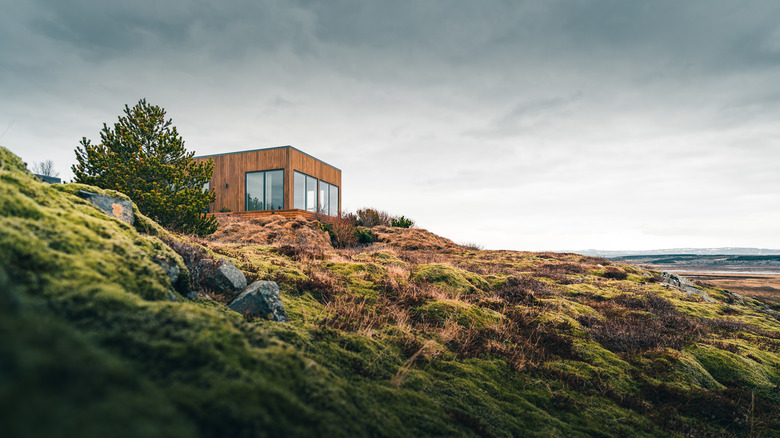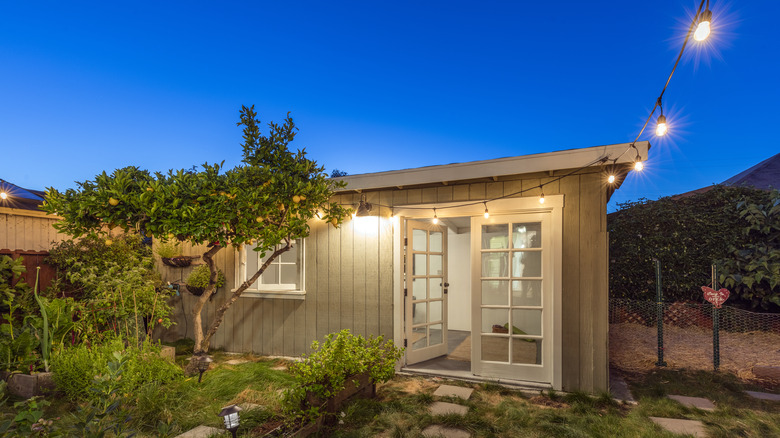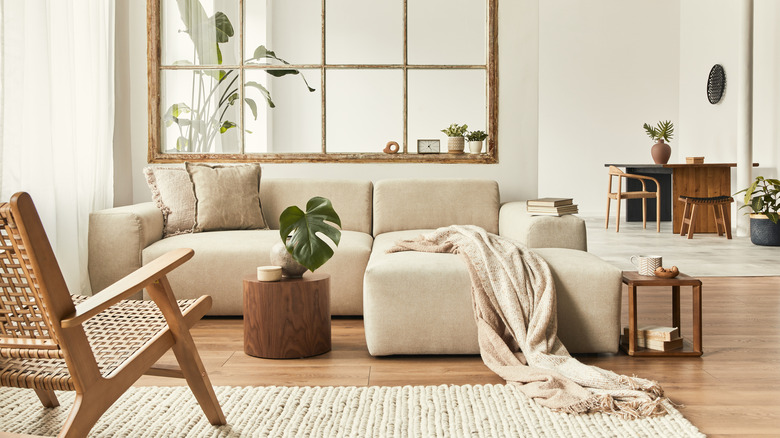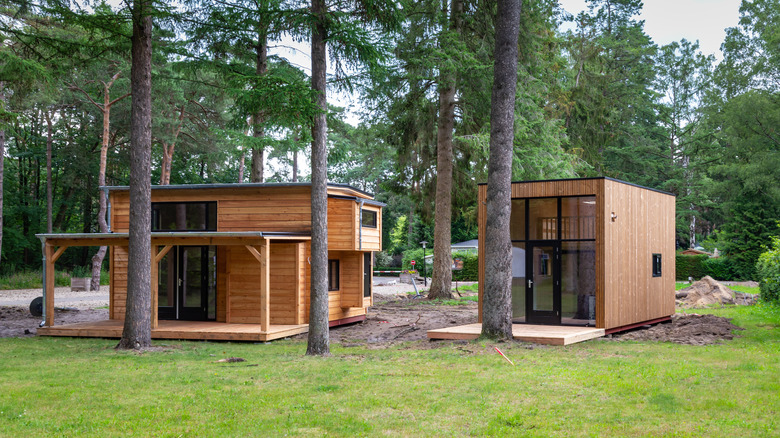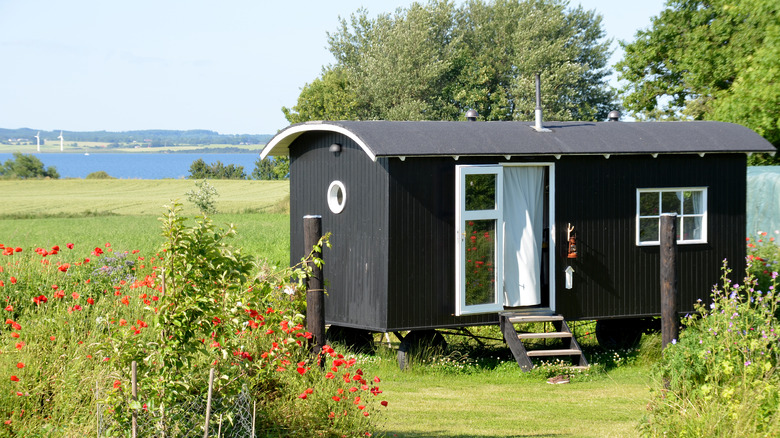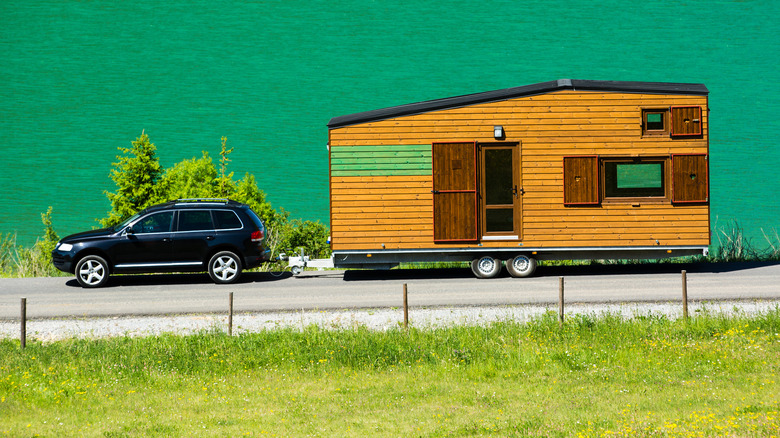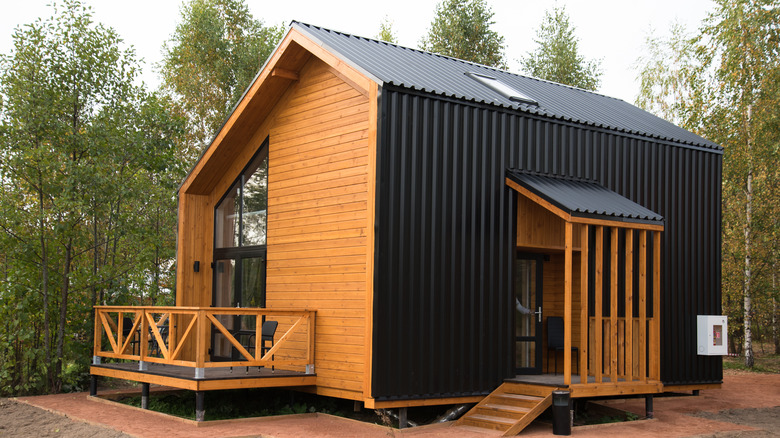How Much Does It Cost To Build A Tiny House?
While the average American home size is around 2,700 square feet, tiny homes (about 80 to 400 square feet) are quite popular. These minute residences have a long tradition in the United States that goes back to pioneer times. The Sioux, Inuit, and Samoans all embraced small accommodations and the first settlers of the New World lived in huts, tents, igloos, and wigwams — all considered precursors for the modern version of tiny houses (via Home Stratosphere).
The price to build such a space varies greatly, depending where you want to live and what features you desire in the home; you can expect to spend about $30,000 to $60,000. Home Advisor, which has a cost estimator, asserts that someone who builds a space without many amenities could spend just $8,000. Those who want something more customized could face expenses up to $150,000 or more.
The average tiny home cost averages $300 per square foot, according to Rocket Mortgage. Your price varies depending on the house size, whether the building is on wheels or a foundation, what materials you use, area permit costs, utility access, and other customizations you make. Does this sound intriguing to you? If so, read further and learn how you can have a tiny house of your own.
Factors for cost
Tiny home costs vary wildly and that's because there are many options, such as the following:
Wheels vs. foundations
One of the things you need to consider with a tiny home is whether you'll use wheels or a foundation. Foundations cost about $4 to $7 per square foot. The total expense for this ranges from $35,000 to $68,000, depending on location, cost of land and other factors. You can also go mobile and put your house on wheels — for about $60,000 to $80,000 (via Home Advisor).
Appliances
Your stove, refrigerator and other amenities are costly, ranging from a few thousand dollars to much higher, said Tiny House Giant Journey. In fact, the blogger's own space includes upwards of $10,000 in appliances.
Materials
What type of materials will you use when building your tiny house? If you want to go eco-friendly, you might include items like a solar generator (about $3,000) or a compost toilet (some $900), said Tiny House Giant Journey. Depending on your environment do you need a heating or cooling system? All this factors into price.
Geographic location
Some spots are cheaper to build tiny homes in than others. For example, North Dakota, Arkansas, Kansas, and Mississippi offer cheaper rates for those wishing to save money, according to Insider. The all-time-lowest cost to buy a minute abode — typically 196 square feet — is found in North Dakota, where you'll spend $28,000 for a sweet home, compared to the $149,000 a Hawaiian location with 278 square feet would nab.
Additional costs
If only you could name a price and then that dollar amount never rose, but that's not how homes come into being. Rather, you get an estimate and then wait for the unexpected costs to appear. Here are some possible tiny house expenses that you may incur:
Utilities
Hopefully, your tiny home is on a location where you can hook into local services easily. But part of the fun of a tiny home is going off-grid, and that might require you to install items like a septic system to aid your plumbing or solar panels so you have an energy source.
Home insurance
Obtaining insurance for your tiny home can become expensive, depending on your location, the type of dwelling, etc.
Storage
Sure the point of going small is to downsize, but some things you might need to store. After all, you are not going to throw away your grandmother's treasured statuettes, are you?
New furnishings
Moving from a regular-sized home to a tiny house might require new furniture. Your big comfy couch, end tables, and chairs might not fit (in size and décor) in the new space, as noted by Rocket Mortgage.
Types of tiny houses
While there are many styles you can apply while designing your tiny house, only two types exist: a recreational vehicle (RV) or a tiny home placed on a foundation, also known as an accessory dwelling unit (ADU).
Recreational vehicle
An RV needs to get registered in your state (another cost you should know about) and most places will also require an inspection (more money) before you can obtain a license plate (more money). Once you've completed this, you just need to find a place to hunker down in; this could include an RV site or a friend or relative's land (providing you get permission), according to Curbed.
Accessory dwelling unit
The ADU route offers more twists and turns. Generally, rules across the nation prevent an individual from purchasing land and putting a tiny house on it — that's where the ADU comes in. This means that your tiny home needs to be the secondary unit on a single-family lot. Tiny house communities do this, for instance, where there's one big structure amid all the tiny homes. ADUs are similar to carriage and coach houses. There are three kinds of ADUs:
- Detached: a stand alone structure
- Attached: a unit connected to a main house
- Interior ADU: a separate section within the main home, like an attic or basement space.
Tiny homes fall under the detached type of ADU (per Better Homes & Gardens).
Ways to build tiny houses
When building a tiny home, you have a few choices in terms of who does the construction. You can go the traditional "from scratch" route and hire an architect and a builder, etc., then leave the details to them. Or you can try the prefab journey, which can sometimes save money. Like anything else, the more features you require, the higher the price soars. Costs for prefab tiny homes can run anywhere from $4,000 to $180,000, depending on whether you purchase a DIY kit with blueprints and a supply list for a simple shelter or a modular for a high-end tiny home with all the bells and whistles, as noted by Home Advisor.
Kit homes cost under $10,000, but this is not a DIY project you want to do without prior construction experience, so this option isn't for everyone. Modular homes skew higher, but offer premade components that fit together to create your new home (via Rocket Mortgage). Modular homes are built off-site and are customized to your specifications; when completed they are brought to the site of your already created foundation and the sections are put together to create your home. Modular homes take less time to construct since they are made in climate-controlled factories not subject to the vagaries of weather. Plus, labor costs are less expensive.
Where to build tiny houses
Zoning laws, along with building codes, can become problematic for tiny house fans. In many locations, it is hard to legally build such dwellings since zoning laws and building codes typically require a minimum square footage in newly built homes. "There are only a handful of cities across the country that directly address tiny houses," said Alexis Stephens, the national coordinator of the Tiny House Association, to Curbed. While many push for changes to such rulings, change is slow.
So before deciding what type of tiny home you want, be sure to find a location for it first. Every area has its own rules and you need to do your research to see what zoning, building, and inspection laws apply to the municipality you want to settle in. Discover, too, what fees you might expect during your building process. "Whatever you do, play by the jurisdiction's rules," advised Rachel Preston Prinz, who runs an architectural firm, to Reader's Digest. "Rural areas usually have more lenient laws, so choosing rural areas may save you money. But what you save here might get eaten up on connecting to the utilities' grid."
Benefits of tiny houses
Tiny houses may give you smaller rooms and storage, but you'll also find that once you reduce your square footage, you get less expenses, maintenance, and energy use. Plus, as Money Crashers points out, you can also take your tiny home on the road (if it's on a trailer) and place it in compact areas so you need less land. Want to go off the grid? Tiny houses are perfect for that since a wood stove can heat the entire place and you can power up with solar technology. A composting toilet allows you to process waste without a sewage system.
All of these things make owning a tiny home appealing. In fact, in a survey by IPX, a Fidelity National Financial Company, respondents said tiny home living was desired because of its affordability (65%), efficiency (57%), eco-friendliness (48%), and the ability it provides to downsize (44%). Embracing the simpler life has other benefits, too, like less housework and more time for things you enjoy, like hobbies, nature walks, and the ones you love.
